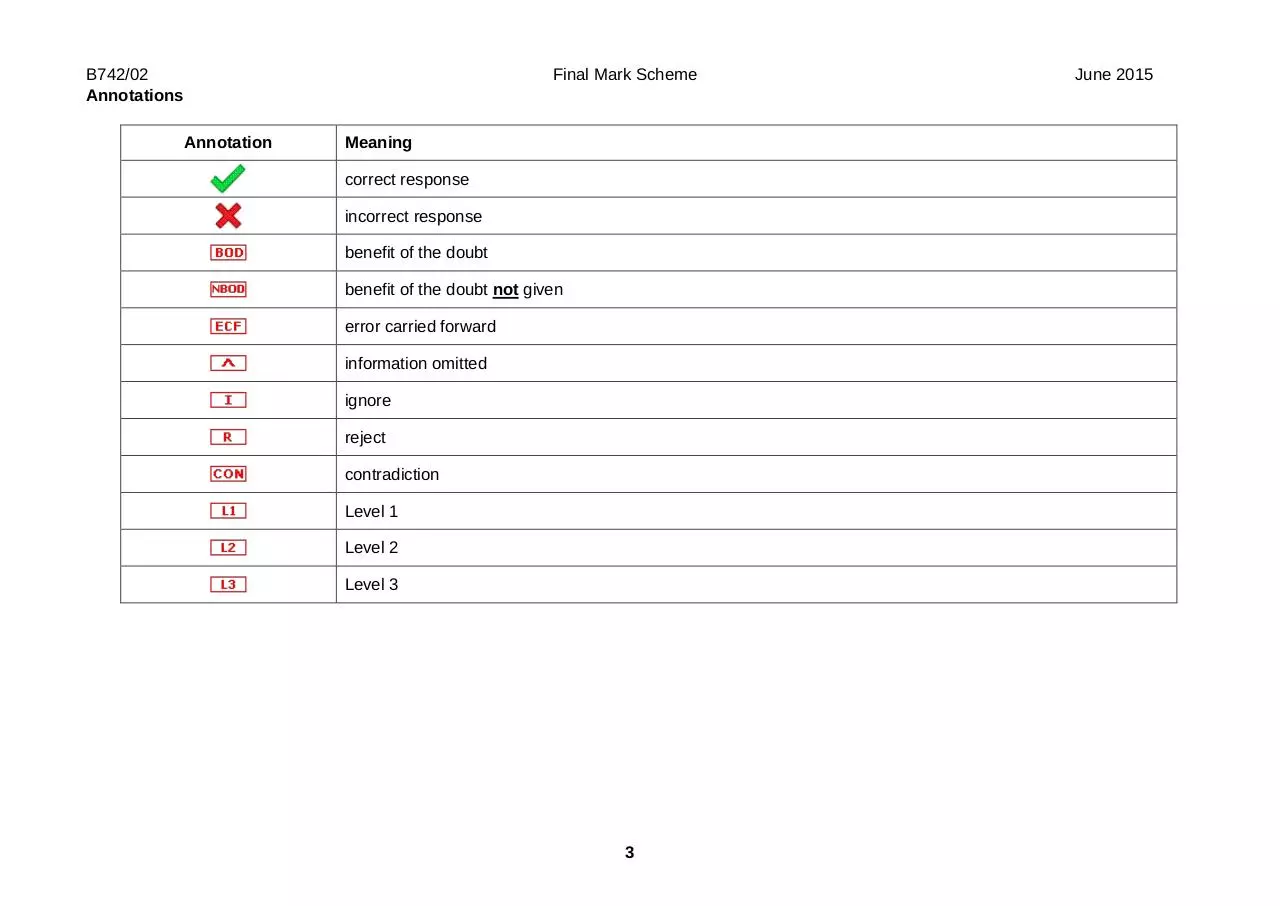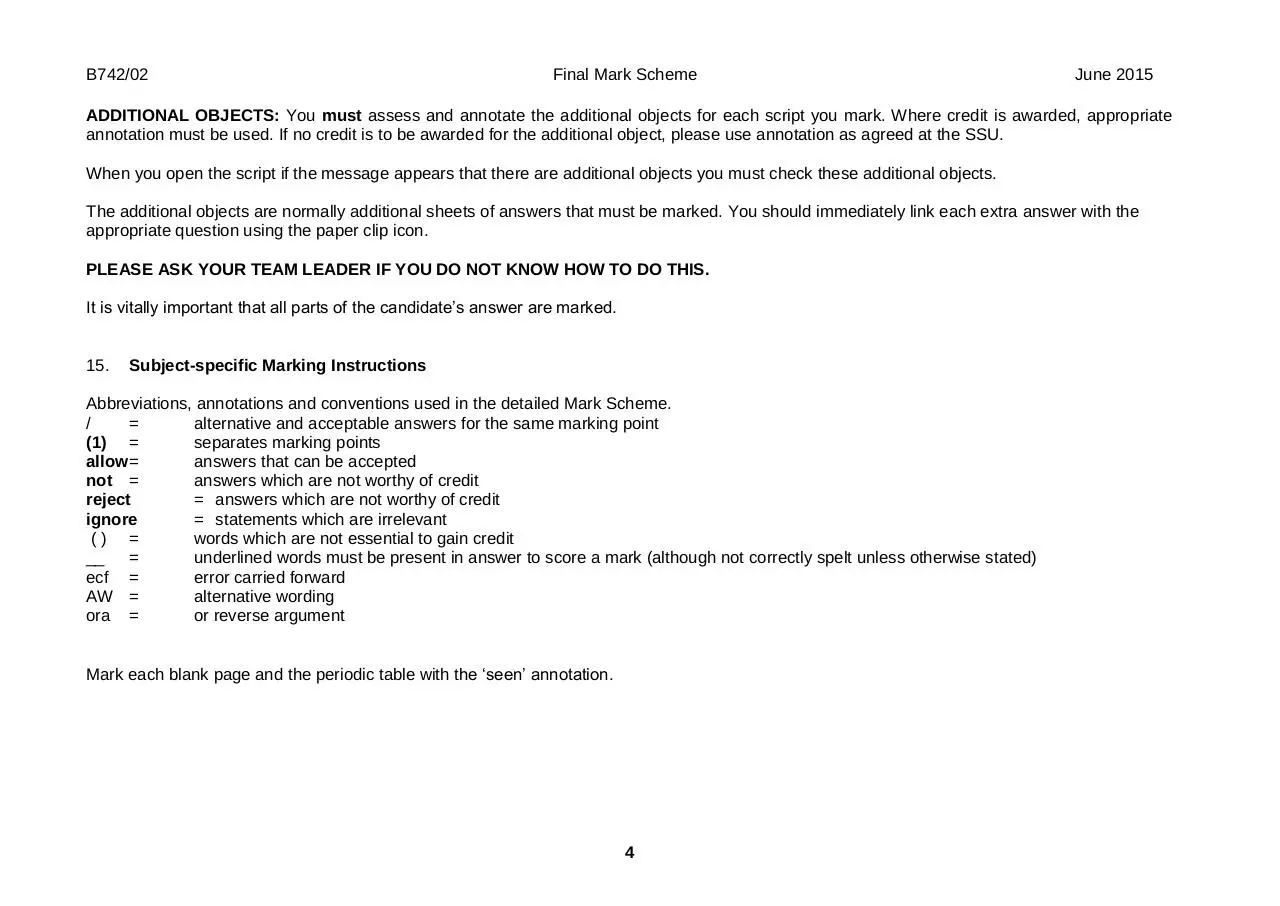C4, C5, C6 Mark Scheme (PDF)
File information
Title: Mark scheme B742/02 Modules C4, C5, C6 (Higher Tier) June 2015
Author: OCR
This PDF 1.5 document has been generated by Microsoft® Word 2010, and has been sent on pdf-archive.com on 19/06/2016 at 14:54, from IP address 90.199.x.x.
The current document download page has been viewed 823 times.
File size: 471.31 KB (23 pages).
Privacy: public file





File preview
GCSE
Chemistry B
Unit B742/02: Modules C4, C5, C6 (Higher Tier)
General Certificate of Secondary Education
Mark Scheme for June 2015
Oxford Cambridge and RSA Examinations
OCR (Oxford Cambridge and RSA) is a leading UK awarding body, providing a wide range of
qualifications to meet the needs of candidates of all ages and abilities. OCR qualifications
include AS/A Levels, Diplomas, GCSEs, Cambridge Nationals, Cambridge Technicals,
Functional Skills, Key Skills, Entry Level qualifications, NVQs and vocational qualifications in
areas such as IT, business, languages, teaching/training, administration and secretarial skills.
It is also responsible for developing new specifications to meet national requirements and the
needs of students and teachers. OCR is a not-for-profit organisation; any surplus made is
invested back into the establishment to help towards the development of qualifications and
support, which keep pace with the changing needs of today’s society.
This mark scheme is published as an aid to teachers and students, to indicate the requirements
of the examination. It shows the basis on which marks were awarded by examiners. It does not
indicate the details of the discussions which took place at an examiners’ meeting before marking
commenced.
All examiners are instructed that alternative correct answers and unexpected approaches in
candidates’ scripts must be given marks that fairly reflect the relevant knowledge and skills
demonstrated.
Mark schemes should be read in conjunction with the published question papers and the report
on the examination.
OCR will not enter into any discussion or correspondence in connection with this mark scheme.
© OCR 2015
2
B742/02
Annotations
Final Mark Scheme
Annotation
Meaning
correct response
incorrect response
benefit of the doubt
benefit of the doubt not given
error carried forward
information omitted
ignore
reject
contradiction
Level 1
Level 2
Level 3
3
June 2015
B742/02
Final Mark Scheme
June 2015
ADDITIONAL OBJECTS: You must assess and annotate the additional objects for each script you mark. Where credit is awarded, appropriate
annotation must be used. If no credit is to be awarded for the additional object, please use annotation as agreed at the SSU.
When you open the script if the message appears that there are additional objects you must check these additional objects.
The additional objects are normally additional sheets of answers that must be marked. You should immediately link each extra answer with the
appropriate question using the paper clip icon.
PLEASE ASK YOUR TEAM LEADER IF YOU DO NOT KNOW HOW TO DO THIS.
It is vitally important that all parts of the candidate’s answer are marked.
15.
Subject-specific Marking Instructions
Abbreviations, annotations and conventions used in the detailed Mark Scheme.
/
=
alternative and acceptable answers for the same marking point
(1) =
separates marking points
allow =
answers that can be accepted
not =
answers which are not worthy of credit
reject
= answers which are not worthy of credit
ignore
= statements which are irrelevant
() =
words which are not essential to gain credit
__ =
underlined words must be present in answer to score a mark (although not correctly spelt unless otherwise stated)
ecf =
error carried forward
AW =
alternative wording
ora =
or reverse argument
Mark each blank page and the periodic table with the ‘seen’ annotation.
4
B742/02
Final Mark Scheme
Question
1 a i
ii
iii
b
Answer
W (1)
Z (1)
Marks
1
1
June 2015
Guidance
allow sodium / Na
allow argon / Ar
W and Y (1)
1
both required but order is unimportant
At least one pair of electrons shared correctly
between nitrogen and hydrogen (1)
2
allow sodium or Na and chlorine or Cl
can use all dots or all crosses
not ionic structures = 0 for the question
allow Lewis diagrams i.e. without circles
allow lone pair electrons as two single electrons
remainder of structure correct (1)
ignore inner electrons on nitrogen
c
solid – ions not free / ions cannot move / ions held in
a lattice / ions in a giant structure (1)
2
dissolved in water – ions can move (1)
ignore electrons / particles cannot move in a solid
allow has free ions
not electrons can move in a liquid
ignore particles can move in a liquid
Total
7
5
B742/02
Final Mark Scheme
Question
2 a
Answer
Number of
protons
Number of
neutrons
Number of
electrons
Chlorine atom
Oxide ion
17
8
20
8
17
10
Marks
3
June 2015
Guidance
chlorine - number of protons and number of neutrons
correct (1)
oxide ion – number of neutrons correct (1)
b
- number of electrons correct (1)
J J Thomson - discovered the electron (1)
2
ignore reference to plum pudding model
allow discovered that atoms have electrons
not electrons were found in the nucleus / discovered that
electrons orbit the nucleus / reference to ions
not discovered neutrons or protons
negative particles in shells is not sufficient
Bohr suggested - that electrons occupy orbits /
electrons in shells / electrons in energy levels (1)
allow reference to orbitals
ignore reference to other aspects of atomic structure e.g.
protons and neutrons
Total
5
6
B742/02
Question
3
Final Mark Scheme
Answer
Level 3
Candidate applies knowledge to predict the name
of both products AND predicts a reaction time for
rubidium AND writes a correctly balanced symbol
equation.
Quality of written communication does not impede
communication of the science at this level.
(5 – 6 marks)
Level 2
EITHER
Candidate applies knowledge to predict the
names of both products AND predicts a reaction
time for rubidium
OR
predicts a reaction time for rubidium AND
attempts a symbol equation.
Quality of written communication partly impedes
communication of the science at this level.
(3 – 4 marks)
Level 1
EITHER
Candidate applies knowledge to predict the
names of both products
OR
predicts a reaction time for rubidium and the
name of one product
OR
candidate attempts a symbol equation.
Quality of written communication impedes
communication of the science at this level.
(1 – 2 marks)
Level 0
Insufficient or irrelevant science. Answer not worthy of
credit.
(0marks)
Marks
6
June 2015
Guidance
This question is targeted at grades up to A*.
Indicative scientific points may include:
Names of Products
hydrogen must be stated but can be in a word equation
rubidium hydroxide must be stated but can be in a word
equation
Reaction Time
any time less than 7 seconds / reaction time less than
potassium
Equation
2Rb + 2H2O 2RbOH + H2 or correct multiple
note Rb + H2O product / formula is an attempt to write an
equation
Use the L1, L2, L3 annotations in Scoris; do not use ticks.
6
7
B742/02
Question
4 a
b
Final Mark Scheme
Answer
(purification processes) do not remove dissolved or
soluble substances (1)
large energy requirement (1)
Marks
1
2
June 2015
Guidance
allow they are soluble / they are dissolved
allow heat for energy
allow high cost of equipment
expensive (1)
allow issues related to scaling up / needs lots of water (1)
c
Pete is right about A but wrong about B (no mark)
4
ignore takes a long time
allow Pete is wrong
not Pete is wrong about A for marks about A
not Peter is correct for B for marks about B
A contains copper (ions) because it gives a blue (ppt)
with sodium hydroxide (1)
copper sulfate goes blue with sodium hydroxide is not sufficient
A contains sulfate (ions) because it gives a white (ppt)
with barium chloride (1)
copper sulfate goes white with barium chloride is not sufficient
B contains iron(III) (ions) because it gives a brown
(ppt) with sodium hydroxide (1)
iron(III) sulfate goes brown with sodium hydroxide is not
sufficient
B does not contain sulfate (ions) as it does not give a
white (ppt) with barium chloride (1)
B is not iron(III) sulfate because it does not go white with
barium chloride is not sufficient
allow B does not contain sulfate as it does not give a ppt
allow A and B both cannot be sulfates since they do not both go
white with barium chloride (2)
Total
7
8
B742/02
Question
5 a
b
Final Mark Scheme
Answer
Marks
1
239 (1)
FIRST LOOK AT THE ANSWER
IF ANSWER = 33% AWARD 2 MARKS
June 2015
Guidance
2
0.33 g (1)
allow ecf from wrong mass
33 (%) (1)
c
C2H5 (1)
1
allow any order of symbols
not C2H5 / C2H5 / or use of lower case H
d
FIRST LOOK AT THE ANSWER
IF ANSWER = Fe2O3 AWARD 3 MARKS
symbols
mole ratio
3
Fe
O
or 1.25
or 1.875
If fraction is the wrong way around = 0 marks for the question
If divide by atomic number = 0 marks for the question
If just use ratio of masses = 0 for the question
simplest mole
ratio
or 1
or 1.5
mole ratio (1)
simplest mole ratio (1)
allow ecf from mole ratio
empirical formula is Fe2O3 (1)
allow ecf from simplest ratio
allow FeO1.5 = 2 marks for the question
Total
7
9
Download C4, C5, C6 Mark Scheme
C4, C5, C6 Mark Scheme.pdf (PDF, 471.31 KB)
Download PDF
Share this file on social networks
Link to this page
Permanent link
Use the permanent link to the download page to share your document on Facebook, Twitter, LinkedIn, or directly with a contact by e-Mail, Messenger, Whatsapp, Line..
Short link
Use the short link to share your document on Twitter or by text message (SMS)
HTML Code
Copy the following HTML code to share your document on a Website or Blog
QR Code to this page

This file has been shared publicly by a user of PDF Archive.
Document ID: 0000390284.